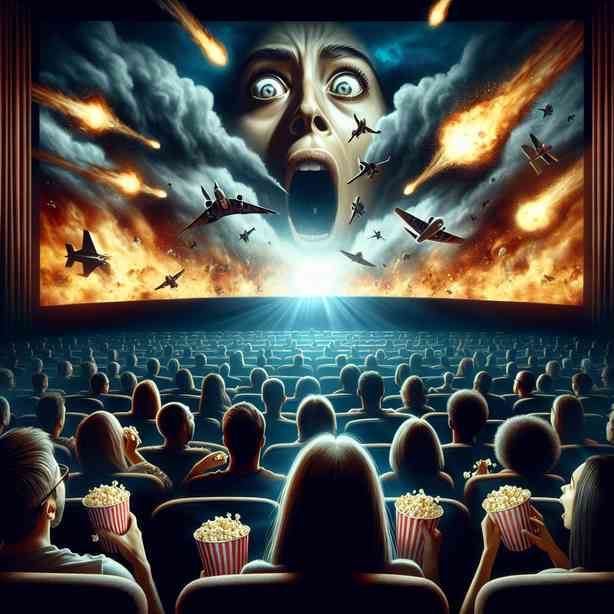
The moments in films or television shows that leave us gasping for breath are often those that catch us completely off guard. These powerful scenes not only evoke an emotional response but also shape the narratives and characters in profound ways. They create an experience that lingers long after the credits roll. Let us delve into some of the most memorable moments in cinematic and television history that have made audiences gasp, exploring their significance, impact, and the reasons behind their lasting impression.
One of the most iconic examples of a scene that made viewers gasp is from the widely acclaimed film “The Sixth Sense,” directed by M. Night Shyamalan. The film revolves around a young boy named Cole Sear, who claims to see dead people. As the story unfolds, we become deeply invested in Cole’s experience and the struggles of Dr. Malcolm Crowe, played by Bruce Willis, who is trying to help him. The moment when Dr. Crowe finally realizes he has been dead throughout the film is incredibly shocking. This twist not only alters our understanding of the entire narrative but also reinforces the film’s themes of acceptance and unresolved issues. The gasp-inducing climax serves as a reminder of the importance of storytelling that challenges our perceptions and emotions seamlessly.
Another pivotal scene comes from “Game of Thrones,” a series notorious for its unpredictable plot twists and shocking character deaths. The Red Wedding is perhaps one of the most brutal and unexpected moments in television history. Set during a wedding celebration, the audience is led to believe that the event will mark a turning point for several main characters. Instead, it devolves into a horrifying massacre featuring the deaths of key characters who had been central to the plot. This scene horrified and shocked viewers, resulting in numerous gasps as they watched beloved characters fall victim to betrayal. The significance of this scene lies not only in its shock value but also in its reflection of the harsh realities of power struggles and loyalty in the world of the series. It serves as a bold narrative choice that underscores the inherent unpredictability of life and death in the show’s universe.
In the realm of superhero films, “Avengers: Infinity War” features a scene that left audiences in stunned silence. Thanos, the primary antagonist, successfully acquires all six Infinity Stones and wipes out half of all life in the universe with a simple snap of his fingers. The gasp-inducing moment comes when we see beloved characters like Spider-Man, Black Panther, and others disintegrate into dust. This sequence not only shocked viewers but also sparked discussions about sacrifice, loss, and the moral complexities of wielding power. The emotional weight of this moment is compounded by the fact that it challenges the genre’s usual portrayal of heroes always triumphing. Instead, it confronts viewers with the harsh reality of loss, making the gasp memorable and meaningful.
Another unforgettable scene that made audiences gasp occurs in the horror film “Get Out,” directed by Jordan Peele. The story follows Chris, an African American man, who visits his white girlfriend’s family for the weekend, only to discover a sinister secret. The moment Chris realizes the true nature of the hypnosis he has been subjected to, combined with revelations of body snatching, creates an intense sense of dread. Viewers find themselves gasping not just from the shock of the twist, but also from the further implications of racism and the commodification of Black bodies. This cinematic moment serves as a profound commentary on contemporary societal issues while effectively using suspense and horror to convey its message.
In romance, a powerful gasp-inducing scene can be found in “The Notebook.” The poignant moment when Noah reads to Allie from their old house depicts the unwavering love they share despite the barriers that life has thrown their way. Many find themselves gasping at the raw, authentic emotions displayed and the depth of commitment between the characters. This scene encapsulates the complexity and beauty of love, reminding us why we often connect so deeply with stories of romance and the lengths to which people go for their loved ones. It serves as a reminder of the passion and vulnerability that come with intimate relationships.
Furthermore, animated films also boast their share of gasp-worthy moments. In “Up,” the opening montage depicting Carl and Ellie’s life is a breathtaking and emotional rollercoaster. Viewers cannot help but gasp as they experience the joys and heartaches of a lifelong relationship in just a few minutes. This scene elaborately sets the stage for Carl’s journey and establishes the emotional stakes in a way that resonates with audiences of all ages. The artistry of this moment lies in its ability to convey complex emotions without uttering a single word, highlighting the power of visual storytelling.
In conclusion, scenes that make us gasp out loud are an essential part of film and television. They challenge our expectations, evoke deep emotions, and leave lasting impressions that echo in our minds long after we’ve experienced them. From surprising twists and shocking revelations to raw emotional connections, the moments designed to provoke gasps also serve to enhance the narrative and thematic depth of the work. Whether it’s through horror, romance, or drama, creators weave these impactful scenes into their stories, reminding us that the most memorable experiences often leave us breathless. As we reflect on these gasp-inducing moments, we find a common thread: they remind us of our humanity, our vulnerabilities, and the intricate stories we share through the medium of film and television.


